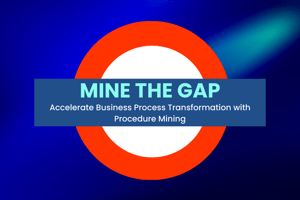process mining process mapping process modeling
Process Modeling vs. Process Mining: Is there a place for both?
In Business Process Management, terms like process mapping, process modeling and process mining are often used interchangeably. To get a picture of how each element of process management can help you manage change and achieve goals, clear distinctions between all three terms should be drawn.
Process Mapping
This is a visual method of planning and visualizing processes. This on-paper representation of your business identifies data, activities, people and materials involved in executing a process. In order to draw these maps, the process must be investigated and discovered by different methods of data capture.
Process Modeling
Process modeling is often referred to as the ‘de jure’ model of process discovery, relying on human perception and input to build a picture of how a business process works, or at the very least how it should work. It is, by nature a subjective view of reality.
Process Mining
Process mining is the ‘de facto’ model of process discovery and involves using automation to extract data from existing sources to build a detailed topography of a business process. This can reveal fact-based insights into how business processes transpire in reality and can detail all exceptions to the rule, potentially showing not only how processes work but perhaps even more crucially how they don’t work.
A time and a place for both
Process modeling is often considered to be the manual, more labor-intensive predecessor of big-data-driven process mining. But that presumes the outcome and purpose of each form of process discovery to be equal. It is, therefore, a false equivalence.
Process mining and process modeling can be used for different purposes, and to extract different data that can be used for the same process in conjunction with each other, like building a target operating model design, one of the key capabilities of the BusinessOptix platform.
Process maps derived from process modeling and process mapping can be compared side-by-side to give a crude view of the difference between how you think things are done, or how they should be done, and how things are actually transpiring in reality.
Process modeling can be used to communicate an ideal-world version of how a department, process, business function or even employee should operate. In simple terms, it provides oversight and a clear target everyone should be working towards.
For example, using the BusinessOptix platform, maps derived from process modeling can be used to provide work instructions to a new employee, give stakeholders an overview of how a department works at an organizational level, or establish and analyze compatibility and process standardization across multiple branches or subsidiaries.
Process mining is much more about automation, and perhaps much more a part of process transformation than simply process management. It’s about delving deeply into the true, inner workings of a business to achieve actionable, hard data-evidenced insights and ultimately drive improvement.
Both types of data capture provide important insight
As we have discussed previously, the human element of process management should never be ignored, and this is where process modeling really comes into its own. Just because a viewpoint is subjective doesn’t make it invalid, and the perception of both internal and external stakeholders can provide valuable insight into operational realities, even providing an explanation for problems.
Process mining can tell you the what, but often process modeling can give much more insight into the why
Process mining can deliver in-depth insights into how a business really works, can be used to drive meaningful organizational change by identifying bottlenecks or inefficiencies, or potential profit leaks or opportunities.
Process modeling is a top-level way to achieve process mapping, and for many aspects of business process management is absolutely sufficient for communicating organizational values.
However you do it, Process Mapping is an essential business intelligence tool
Forbes cites the root cause of process avoidance as one of the main reasons why 9 out of 10 startups don’t make it. Process mapping from day one is a critical element of business success, no matter how it’s done.
Both de facto and de jure methods of process mapping are equally valid and important as part of a business process management strategy, which is why BusinessOptix provides the capability for using both in our suite of end-to-end business process management and transformation tools.
Our process mining function gives your business the opportunity to discover what is really happening in your organization and build an in-depth analysis of where people, processes, and technology are being utilized or wasted.
Our process mapping capabilities give you the opportunity to use data from stakeholders across your organization to create a digital blueprint of your business. You can build a map that represents a detailed insight into your processes, not merely visual oversight – and this can be crafted from a mix of mined data and subjective experiences.
Book a demo with us to see firsthand how different methods of data capture can blend together to give you a truly holistic view of your organization and transform your ability to manage how it operates.



